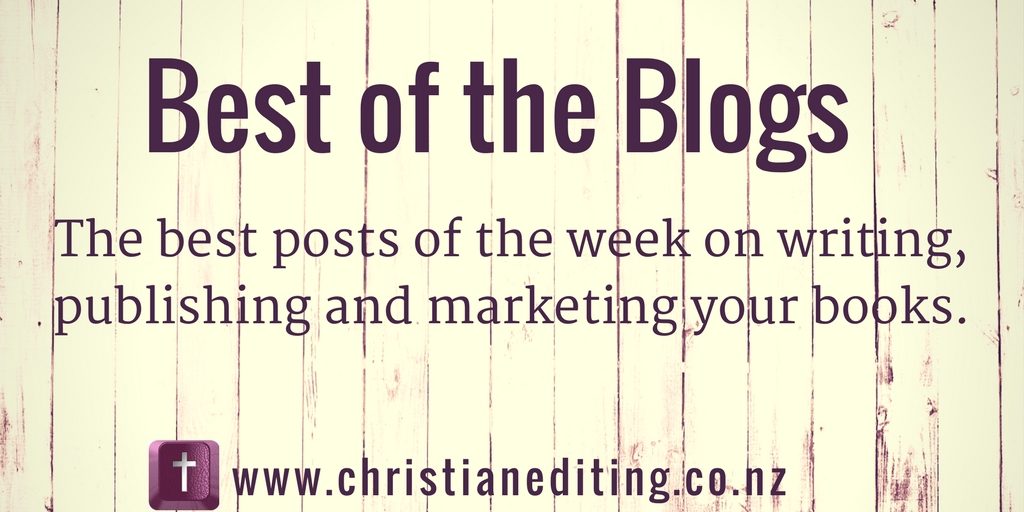The best of the blogs: must-read posts on writing, editing, publishing, and marketing your books.
Writing
Modern fiction is written in scenes … and that’s something a lot of modern writers don’t fully understand. In this excellent (and detailed) post, KM Weiland takes us through the basics of scene structure, gives reasons why we often get confused between scene and sequel, gives an alternative way of looking at theme, scene, and sequel, and provides an example from her own work. This is a great reference post.
Editing
Great writing is more than an interesting plot and wonderful characters. It’s also hooking the reader with every single sentence. Sacha Black explains in Getting Jiggy with the Nitty Gritty, or, Improving Your Sentences in a guest post at Writers Helping Writers.
Note: don’t get bogged down remembering these nitty gritty details as you write your first draft. But do consider these tips as you write and edit. That’s the time to cut the dross and power up your sentences.
Publishing
Ebook Piracy
Tim Grahl discusses whether ebook piracy is a bad thing or a good thing in Ebook Piracy = Sell More Books. He argues that for most authors, the enemy is obscurity, not piracy. If no one knows you exist, they can’t buy your books. He also shares a video clip of author Neil Gamain sharing his view on piracy—that his own sales went up in the countries in which his books were most often pirated. Gamain also says:
Because the biggest thing the web was doing is allowing people to hear things, allowing people to read things, allowing people to see things they might never have otherwise seen. And I think, basically, that’s an incredibly good thing.
Tim Grahl also shares some tips for trying to turn pirate readers into paying customers. If Neil Gamain’s publisher can’t stop ebook piracy, nor can you. But you can at least try and turn piracy to your advantage (e.g. if you upload your book to the main pirate sites, you control the content and can make sure it includes your email signup links).
You’re writing because you want to share your ideas, right? If you’re a Christian author, you may also want to share the Good News. People who might never pick up a Bible or a Christian book might find your pirated novel. And read it. Is that a bad thing?
Marketing
What Works?
New York Times bestselling author Brenda Novak shared 9 Book Advertising Tactics I’ve Tried … And Which Ones Worked at the BookBub blog (yes, she recommends BookBub). She found print advertising didn’t result in sales (it may have increased awareness, but that’s impossible to quantify).
She also hosted a reader event for 150 people. Even though she charged $40 for tickets, the event still cost her $7,500. A better option might have been to join in with other authors, or speak at a reader-organised event. If you write Christian fiction, check out the Christian Fiction Readers Retreat as an option. Plans are in the works for a 2018 event.
Author Interview: Bethany Turner
I’m sharing this interview because Bethany Turner is an example of how you can break a lot of the writing and publishing industry “rules” if your writing is strong enough. Examples:
- It’s written in first person
- She talks directly to the reader
- The first 10% of the book is backstory
- It uses the (unrealistic, IMO) Love at First Sight trope.
- And the (hated, IMO) Other Woman trope
- It includes swearing
- The hero and heroine are sexually attracted. In Christian fiction.
Despite all that, it’s the first book I’ve read this year where I immediately wanted to sit down and read it again.
She also broke several publishing industry rules
- Turner admits she didn’t read the genre (Christian romance)
- She never read books on writing craft or attended a conference
She didn’t have an agent - She got a contract from a major publisher by submitting to Writer’s Edge (the first fiction example I’ve seen in years)
I don’t recommend following Bethany’s example—she is the exception, not the rule. But I do recommend reading the interview (and her book, The Secret Life of Sarah Hollenbeck, which I featured yesterday on #FirstLineFriday).
Social Media Fun
Finally, for laughs: 30 of the Funniest Tweets About Social Media
My favourite is #18, with #19 running a close second. What’s yours?




